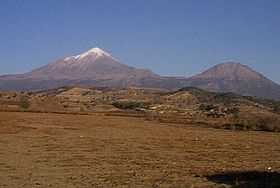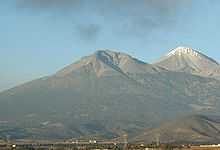Sierra Negra
| Sierra Negra | |
|---|---|
 Pico de Orizaba and Sierra Negra viewed from the west, near Ciudad Serdán | |
| Elevation | 4,640 m (15,223 ft) |
| Prominence | 500 m (1,640 ft) |
| Location | |
| Location | Chalchicomula de Sesma, Puebla, Mexico |
| Coordinates | 18°59′N 97°19′W / 18.983°N 97.317°WCoordinates: 18°59′N 97°19′W / 18.983°N 97.317°W |
| Geology | |
| Type | Stratovolcano |
| Volcanic arc/belt | Trans-Mexican Volcanic Belt |
| Last eruption | 2005 |


Sierra Negra (also, and perhaps more properly, Cerro La Negra) is an extinct volcanic companion peak of Mexico's highest mountain, the Pico de Orizaba (Citlaltepetl). At up to 4,640 m (15,220 ft) above sea level (depending on which source one consults) it is one of Mexico's highest peaks, perhaps even the fourth highest, though it is usually listed fifth. However, because it is overshadowed by its much higher companion it is not as well known as, for instance, the slightly lower Matlalcueitl (Malinche), and is often not included in lists of Mexico's mountains.
Overview
The summit of Sierra Negra is the site for one of the world's premier astronomical instruments, the Large Millimeter Telescope. The service road for this project is claimed to be the highest road in North America. A part of the telescope facility is visible as a white dot in the first picture below and more clearly in the second picture.
The name Sierra Negra is confusing, because a 'Sierra' is usually a mountain range rather than a single peak, and there is a Sierra often called the Sierra Negra which lies to the south of this peak, along the border of the states of Puebla and Veracruz. However, it is the name that occurs on the official INEGI maps and is the one that is most commonly used by English speakers to refer to the mountain. The Nahuatl names "Tliltepetl" or "Atlitzin" are attached to it by some, though they have also been used for other mountains in the area. Speakers of Orizaba Nahuatl call the mountain Istaktepetl Ikni 'the White Mountain's Sibling' (the Pico de Orizaba being the White Mountain).
See also
- 4000 meter peaks of México
- 4000 meter peaks of North America
- Mountain peaks of México
- Mountain peaks of North America
References
- "Pico de Orizaba". Global Volcanism Program, Smithsonian Institution. http://www.volcano.si.edu/world/volcano.cfm?vnum=1401-10%3D. (includes Sierra Negra)
- Yarza de la Torre, Esperanza (1971). Volcanes de México. Aguilar. p. 237 pp. (in Spanish)
External links
- The Large Millimeter Telescope (The altitude figure of 4640 m is from this site)
- Peakbagger.com: Sierra Nerga